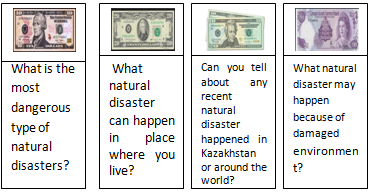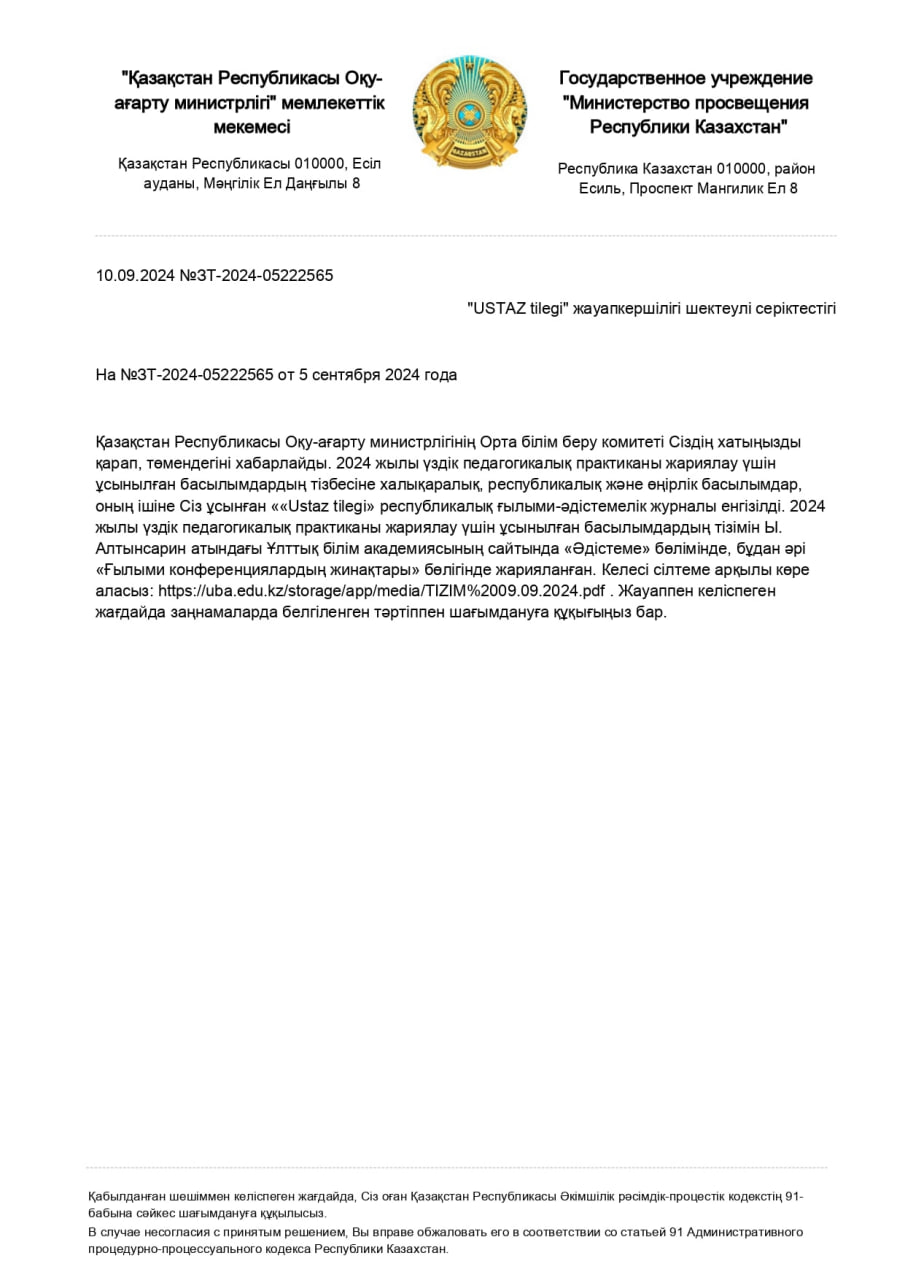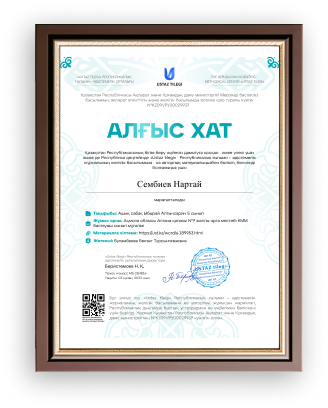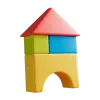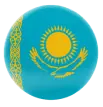
|
Unit of a long term plan: 7 Natural Disasters. |
School: |
||||||||||||||||||||||||||||||||||||||||||||||||||||||||
|
Date: |
Teacher`s name: |
||||||||||||||||||||||||||||||||||||||||||||||||||||||||
|
CLASS: |
Number present: |
absent: |
|||||||||||||||||||||||||||||||||||||||||||||||||||||||
|
Lesson title |
Discussion about Disaster statistics in Kazakhstan |
||||||||||||||||||||||||||||||||||||||||||||||||||||||||
|
Learning objectives(s) that this lesson is contributing to (link to the Subject programme) |
7. C9 use imagination to express thoughts, ideas, experiences and feelings. 7.L5 understand most specific information detail of supported, extended talk on a range of general and curricular topics; 7.S7 use appropriate subject-specific vocabulary and syntax to talk about a range of general topics, and some curricular topics; |
||||||||||||||||||||||||||||||||||||||||||||||||||||||||
|
Lesson objectives |
All learners will be able to: - recognize basic information using subject-specific vocabulary to express thoughts, ideas according to the theme “Disaster statistics in Kazakhstan” with support; Most learners will be able to: - utilize specific information using subject-specific vocabulary to express thoughts, ideas according to the theme “Disaster statistics in Kazakhstan” with little support; Some learners will be able to: -make a discussion and utilize specific information using subject-specific vocabulary to express thoughts, ideas according to the theme “Disaster statistics in Kazakhstan” without support; |
||||||||||||||||||||||||||||||||||||||||||||||||||||||||
|
Assessment criteria |
Apply topic related vocabulary in speech appropriately arranging words and phrases into well-formed sentences |
||||||||||||||||||||||||||||||||||||||||||||||||||||||||
|
Values links |
The Patriotic Act “Mangilik Yel” The 7th value: Country`s national security and its engagement in addressing global and regional issues. |
||||||||||||||||||||||||||||||||||||||||||||||||||||||||
|
Cross-curricular links |
Geography |
||||||||||||||||||||||||||||||||||||||||||||||||||||||||
|
Previous learning |
Learners have already studied the words for the topic natural disasters this term |
||||||||||||||||||||||||||||||||||||||||||||||||||||||||
|
Plan |
|||||||||||||||||||||||||||||||||||||||||||||||||||||||||
|
Planned timings |
Planned activities (replace the notes below with your planned activities) |
Resources |
|||||||||||||||||||||||||||||||||||||||||||||||||||||||
|
Start 7 min |
Greeting and organization moment. Teacher greets the learners Divide into groups using the name of disaster regions of Kazakhstan (Aral sea and Baikonur) Checking up the home task. “Dollar awards” strategy. There is given dollars questions learners should choose one card.
If a student answers incorrectly they must pay a penalty of five dollar to all the other players. And with the help of this method students should discover the new theme Teacher introduce the lesson objectives and learning objectives |
Pictures with dollars |
|||||||||||||||||||||||||||||||||||||||||||||||||||||||
|
Middle 28min |
Pre-listening:Task1 Method “Think together” Students find the equivalents to the words and match the definitions given in the chart. Differentiation by difficulty of task More able learners have questions and need to complete the table with answers; less able learners have options to complete the table Before listening learners receive cut cards with the words and their definitions in English (for more able learners) and with Kazakh translations (for less able learners). Learners receive differentiated listening tasks; they are going to listen two different talks about hurricanes and floods. Didactic material for less able learners.
Didactic material for more able learners.
Descriptor: A learner - understand their meanings; - match the words; AFL: group assessment While-listening task: Task 2. Tapescript1.Method “Who is fastest” Learners should write missing words and make whole sentence. Differentiation by scaffolding (with key words and pause) More able learners listen to the text “Natural disaster” independently. Less able learners listen to the text “Natural disasters” with key words and pause. I don’t know about you, but I think there are more natural__________ now than before. Every time I turn on the news there’s some kind of disaster. There are ________in Australia and California, _________in China, __________ in Mexico and droughts in Africa. I’m sure _______ warming is creating more natural _________. I’m lucky. Where I live, we don’t really have natural disasters. I’ve never _________anything like the things on TV. Japan has many natural disasters. They have earthquakes, ________, flooding, _________, all kinds of things. They are lucky they have the _________ to deal with them. There are countries in _________ that aren’t rich. When a natural disaster hits them, __________ suffers terribly. Post-listening: Differentiation by type of task Less able learners write true or false statements 1. There are bushfires in Australia and China. 2. Japan has many natural disasters. 3. There are countries in Africa that very rich. 4. When a natural disaster hits them, everyone suffers terribly After listening more able learners make discussion according to the listening task with the help of method “Moving questions” .This is the activity for giving opinion of students about the topic. All students stand up and make a circle and round the rope and stop. There are sticker on the rope with the given questions according to the previous lesson. Students take a sticker opposite of them and answer the questions. Teacher makes sure they are aware about natural disasters in Kazakhstan: they work in small groups. Following questions:
Descriptor: A learner -listen to the text attentively; -make discussion about text; -make a gap filling; -write true or false; AFL: Teacher`s assessment in orally;
|
Cut cards |
|||||||||||||||||||||||||||||||||||||||||||||||||||||||
|
End |
To conclude the theme teacher reads the text Tell learners you are going to describe a scene that you would like them to draw. Read out the following text: (adapt as appropriate for higher/lower levels). Answers may vary from flood, hurricane, and tsunami. When they have suggested some answers ask them to think of as many different natural disaster as they can.
“Draw three houses on the right in the middle. Each house has four windows and a door. On the roof of one of the houses there are two people and a dog. Draw two trees on the left in the middle. At the top of the picture draw some clouds. The clouds look grey and it’s raining a lot. In the sky there is a helicopter. Around the houses there is water. The water touches the top windows of the house….” Descriptor: A learner -describe a scene;
Homework: Learners are going to create a warning sign for people in Kazakhstan; first they should explore what disasters usually happen in Kazakhstan (some regions) and what people can do in order to prevent them. Assessment criteria:
Assessment: I give the learners self assessment sheets they write what they are learn at today`s lesson.
Feedback: Learners are given sticky papers to write their opinion on the lesson, they should write WOW
|
Stickers |
|||||||||||||||||||||||||||||||||||||||||||||||||||||||
|
Additional information |
|||||||||||||||||||||||||||||||||||||||||||||||||||||||||
|
Differentiation – how do you plan to give more support? How do you plan to challenge the more able learners? |
Assessment – how are you planning to check learners’ learning? |
Health and safety check |
|
||||||||||||||||||||||||||||||||||||||||||||||||||||||
|
Differentiation by difficulty of task More able learners have questions and need to complete the table with answers; less able learners have options to complete the table Differentiation by scaffolding (with key words and pause) More able learners listen to the text “Natural disaster” independently. Less able learners listen to the text “Natural disasters” with key words and pause Differentiation by type of task Less able learners write true or false statements After listening more able learners make discussion according to the listening task |
I give the learners self assessment sheets they write what they are learn at today`s lesson.
|
Health saving technologies. Using physical exercises and active activities. Rules from the Safety Rules book which can be applied in this lesson. |
|
||||||||||||||||||||||||||||||||||||||||||||||||||||||
|
Reflection
Were the lesson objectives/learning objectives realistic? Did all the learners achieve the lesson objectives/ learning objectives? If not, why? Did my planned differentiation work well? Did I stick to timings? What changes did I make from my plan and why?
|
Use the space below to reflect on your lesson. Answer the most relevant questions from the box on the left about your lesson. |
||||||||||||||||||||||||||||||||||||||||||||||||||||||||
|
|
|||||||||||||||||||||||||||||||||||||||||||||||||||||||||
|
Summary evaluation
What two things went really well (consider both teaching and learning)?
1:
2:
What two things would have improved the lesson (consider both teaching and learning)?
1:
2:
What have I learned from this lesson about the class or individuals that will inform my next lesson?
|
|||||||||||||||||||||||||||||||||||||||||||||||||||||||||
жүктеу мүмкіндігіне ие боласыз
Бұл материал сайт қолданушысы жариялаған. Материалдың ішінде жазылған барлық ақпаратқа жауапкершілікті жариялаған қолданушы жауап береді. Ұстаз тілегі тек ақпаратты таратуға қолдау көрсетеді. Егер материал сіздің авторлық құқығыңызды бұзған болса немесе басқа да себептермен сайттан өшіру керек деп ойласаңыз осында жазыңыз
Discussion about Disasters
Discussion about Disasters
|
Unit of a long term plan: 7 Natural Disasters. |
School: |
||||||||||||||||||||||||||||||||||||||||||||||||||||||||
|
Date: |
Teacher`s name: |
||||||||||||||||||||||||||||||||||||||||||||||||||||||||
|
CLASS: |
Number present: |
absent: |
|||||||||||||||||||||||||||||||||||||||||||||||||||||||
|
Lesson title |
Discussion about Disaster statistics in Kazakhstan |
||||||||||||||||||||||||||||||||||||||||||||||||||||||||
|
Learning objectives(s) that this lesson is contributing to (link to the Subject programme) |
7. C9 use imagination to express thoughts, ideas, experiences and feelings. 7.L5 understand most specific information detail of supported, extended talk on a range of general and curricular topics; 7.S7 use appropriate subject-specific vocabulary and syntax to talk about a range of general topics, and some curricular topics; |
||||||||||||||||||||||||||||||||||||||||||||||||||||||||
|
Lesson objectives |
All learners will be able to: - recognize basic information using subject-specific vocabulary to express thoughts, ideas according to the theme “Disaster statistics in Kazakhstan” with support; Most learners will be able to: - utilize specific information using subject-specific vocabulary to express thoughts, ideas according to the theme “Disaster statistics in Kazakhstan” with little support; Some learners will be able to: -make a discussion and utilize specific information using subject-specific vocabulary to express thoughts, ideas according to the theme “Disaster statistics in Kazakhstan” without support; |
||||||||||||||||||||||||||||||||||||||||||||||||||||||||
|
Assessment criteria |
Apply topic related vocabulary in speech appropriately arranging words and phrases into well-formed sentences |
||||||||||||||||||||||||||||||||||||||||||||||||||||||||
|
Values links |
The Patriotic Act “Mangilik Yel” The 7th value: Country`s national security and its engagement in addressing global and regional issues. |
||||||||||||||||||||||||||||||||||||||||||||||||||||||||
|
Cross-curricular links |
Geography |
||||||||||||||||||||||||||||||||||||||||||||||||||||||||
|
Previous learning |
Learners have already studied the words for the topic natural disasters this term |
||||||||||||||||||||||||||||||||||||||||||||||||||||||||
|
Plan |
|||||||||||||||||||||||||||||||||||||||||||||||||||||||||
|
Planned timings |
Planned activities (replace the notes below with your planned activities) |
Resources |
|||||||||||||||||||||||||||||||||||||||||||||||||||||||
|
Start 7 min |
Greeting and organization moment. Teacher greets the learners Divide into groups using the name of disaster regions of Kazakhstan (Aral sea and Baikonur) Checking up the home task. “Dollar awards” strategy. There is given dollars questions learners should choose one card.
If a student answers incorrectly they must pay a penalty of five dollar to all the other players. And with the help of this method students should discover the new theme Teacher introduce the lesson objectives and learning objectives |
Pictures with dollars |
|||||||||||||||||||||||||||||||||||||||||||||||||||||||
|
Middle 28min |
Pre-listening:Task1 Method “Think together” Students find the equivalents to the words and match the definitions given in the chart. Differentiation by difficulty of task More able learners have questions and need to complete the table with answers; less able learners have options to complete the table Before listening learners receive cut cards with the words and their definitions in English (for more able learners) and with Kazakh translations (for less able learners). Learners receive differentiated listening tasks; they are going to listen two different talks about hurricanes and floods. Didactic material for less able learners.
Didactic material for more able learners.
Descriptor: A learner - understand their meanings; - match the words; AFL: group assessment While-listening task: Task 2. Tapescript1.Method “Who is fastest” Learners should write missing words and make whole sentence. Differentiation by scaffolding (with key words and pause) More able learners listen to the text “Natural disaster” independently. Less able learners listen to the text “Natural disasters” with key words and pause. I don’t know about you, but I think there are more natural__________ now than before. Every time I turn on the news there’s some kind of disaster. There are ________in Australia and California, _________in China, __________ in Mexico and droughts in Africa. I’m sure _______ warming is creating more natural _________. I’m lucky. Where I live, we don’t really have natural disasters. I’ve never _________anything like the things on TV. Japan has many natural disasters. They have earthquakes, ________, flooding, _________, all kinds of things. They are lucky they have the _________ to deal with them. There are countries in _________ that aren’t rich. When a natural disaster hits them, __________ suffers terribly. Post-listening: Differentiation by type of task Less able learners write true or false statements 1. There are bushfires in Australia and China. 2. Japan has many natural disasters. 3. There are countries in Africa that very rich. 4. When a natural disaster hits them, everyone suffers terribly After listening more able learners make discussion according to the listening task with the help of method “Moving questions” .This is the activity for giving opinion of students about the topic. All students stand up and make a circle and round the rope and stop. There are sticker on the rope with the given questions according to the previous lesson. Students take a sticker opposite of them and answer the questions. Teacher makes sure they are aware about natural disasters in Kazakhstan: they work in small groups. Following questions:
Descriptor: A learner -listen to the text attentively; -make discussion about text; -make a gap filling; -write true or false; AFL: Teacher`s assessment in orally;
|
Cut cards |
|||||||||||||||||||||||||||||||||||||||||||||||||||||||
|
End |
To conclude the theme teacher reads the text Tell learners you are going to describe a scene that you would like them to draw. Read out the following text: (adapt as appropriate for higher/lower levels). Answers may vary from flood, hurricane, and tsunami. When they have suggested some answers ask them to think of as many different natural disaster as they can.
“Draw three houses on the right in the middle. Each house has four windows and a door. On the roof of one of the houses there are two people and a dog. Draw two trees on the left in the middle. At the top of the picture draw some clouds. The clouds look grey and it’s raining a lot. In the sky there is a helicopter. Around the houses there is water. The water touches the top windows of the house….” Descriptor: A learner -describe a scene;
Homework: Learners are going to create a warning sign for people in Kazakhstan; first they should explore what disasters usually happen in Kazakhstan (some regions) and what people can do in order to prevent them. Assessment criteria:
Assessment: I give the learners self assessment sheets they write what they are learn at today`s lesson.
Feedback: Learners are given sticky papers to write their opinion on the lesson, they should write WOW
|
Stickers |
|||||||||||||||||||||||||||||||||||||||||||||||||||||||
|
Additional information |
|||||||||||||||||||||||||||||||||||||||||||||||||||||||||
|
Differentiation – how do you plan to give more support? How do you plan to challenge the more able learners? |
Assessment – how are you planning to check learners’ learning? |
Health and safety check |
|
||||||||||||||||||||||||||||||||||||||||||||||||||||||
|
Differentiation by difficulty of task More able learners have questions and need to complete the table with answers; less able learners have options to complete the table Differentiation by scaffolding (with key words and pause) More able learners listen to the text “Natural disaster” independently. Less able learners listen to the text “Natural disasters” with key words and pause Differentiation by type of task Less able learners write true or false statements After listening more able learners make discussion according to the listening task |
I give the learners self assessment sheets they write what they are learn at today`s lesson.
|
Health saving technologies. Using physical exercises and active activities. Rules from the Safety Rules book which can be applied in this lesson. |
|
||||||||||||||||||||||||||||||||||||||||||||||||||||||
|
Reflection
Were the lesson objectives/learning objectives realistic? Did all the learners achieve the lesson objectives/ learning objectives? If not, why? Did my planned differentiation work well? Did I stick to timings? What changes did I make from my plan and why?
|
Use the space below to reflect on your lesson. Answer the most relevant questions from the box on the left about your lesson. |
||||||||||||||||||||||||||||||||||||||||||||||||||||||||
|
|
|||||||||||||||||||||||||||||||||||||||||||||||||||||||||
|
Summary evaluation
What two things went really well (consider both teaching and learning)?
1:
2:
What two things would have improved the lesson (consider both teaching and learning)?
1:
2:
What have I learned from this lesson about the class or individuals that will inform my next lesson?
|
|||||||||||||||||||||||||||||||||||||||||||||||||||||||||

шағым қалдыра аласыз


